Friends, today I offer you the perfect Osso Buco Recipe! I know, I know… I just realized that I haven’t posted a recipe on the blog since May. What say you we change that? Alright? Awesome! Now, regular, functional human beings might have picked something safe for their first efforts in almost 7 months. Me? Not quite so.

There she is: the perfect osso buco in all her rustic beauty!
In a possibly dangerous move, I turned to good friend and fellow food blogger and former national catering champion Malou from Klidmoster.dk and asked her what she would like to see next on the blog. She stated quite simply: My favorite food in the world – perfect Osso Buco using my beloved, late father’s perfect recipe. And I want you to cook it for me on my next visit!
Right, uh, no pressure, right? The name of the game on the blog today is the Italian slow food classic, osso buco or wine-braised veal/beef shanks in more simplified English. You can skip to the perfect osso buco recipe right here, but in this case, I really hope you’ll read on for the back story, more info, history, and a few practical tips for perfect osso buco.
Perfect Osso Buco; A Rockin’ Family recipe
The recipe you’re about to read is a family recipe, not mine, it’s not even from my own family as a matter of fact. While the procedure may be slightly tailored to my liking, it’s not at all mine but belongs to my friend Malou and her family. That being said, the recipe may well be one of the most popular in Denmark, published first on Malou’s own blog and subsequently in popular women’s magazine Alt For Damerne, amongst other approved and not quite so approved recipe outlets.
That being said, the recipe does not come from Malou either it comes courtesy of her dear, beloved father who, sadly, left this world much too soon, leaving an enormous amount of grief and loss to his daughters, but also strength, character, a lifetime of memories and this particular recipe!
Talking to Malou today, even so many years after his passing, it is clear that her father has helped shape her in so many ways, both in terms of character, cultural preferences and an undying culinary passion and curiosity. It’s is also clear that she misses him tremendously.
As a result, today’s dish is one that Malou barely ever cooks herself and being given the opportunity to prepare it for her, let alone write about it, is an absolute honor and privilege. And with that, the disclaimer: This dish isn’t my doing, this one’s for you my friend, and for you, Dad, hopefully gazing down somewhere from the stars wondering just what the fuck this damn kid is doing to your tried and tested recipe!

“To all friends present, past and beyond, to all of those who weren’t with us too long, life is the most precious thing that you can lose…” – Cheers and thanks for the recipe, Starman!
Osso buco: history and myth – right and wrong
Ahem, okay, deep breath! So before we get all caught up in emotion here, let’s have a look at the obvious question: “What the hell is osso buco anyway?”
Osso buco, in its most generic form, is a classic Italian stew made by simmering veal shanks slowly and gently in a wine and vegetable broth for hours and hours until fork tender. Like most Italian dishes, it’s relatively simple to prepare and like most Italian dishes, its history, origin and ingredients are wildly and hotly disputed.
I know, leave it to the Italians to get passionate about food. Anyway, let’s start with what we do know and see if we can figure out a bit of osso buco history.
Osso buco history: The Great Debate
Osso buco is Italian, not surprisingly, for “hole in the bone” (osso = bone, buco = hole) and refers to the defining characteristic of the dish’s main ingredient, veal shank cut across the bone, namely the very visible chunk of bone at the center of the cut with its eye of bone marrow in the middle.
During the prolonged slow cooking needed to tenderize the tough meat, the marrow slowly but steadily melts into the dish, adding a comforting richness. Any remaining marrow can be scooped out and eaten by the diner, leaving a hole in the middle of the bone. Hence, osso buco, hole in the bone.
As for the history, most food historians agree that the dish has its origin in the city of Milan in the Lombardy region of Italy which is why you will often see it on menus and in cook books as Osso Buco alla Milanese. What said food historians can’t seem to agree on is exactly when the dish originated and what the original, traditional ingredients were.
One camp of historians claim that the dish is quite old, dating back to at least the 18th century when the ingredients and combinations thereof became common in Italian cuisine. Others suggest it dates back as far as the Middle Ages in some shape or form while a third fraction suggest that the dish is a modern invention, possiblyto the tune of a hundred years old or less. All camps present very weak evidence for their respective claims, but what we do know for certain is that the first known recipe for osso buco was printed in the 1891 tome of Italian national cuisine La Scienza in Cucina e l’Arte di mangiar bene (The Science in the Kitchen and the Art of Eating well) by Pellegrino Artusi . This, obviously, suggests that the dish was well-known at the time and certainly speaks more in favor of a 18th century or older theories.
But the controversy far from ends here. Rather than simply debating the origin and birth of the dish, self-proclaimed experts are keen to discuss many other aspects of the osso buco, including the ingredients.
What are the traditional osso buco ingredients?
In true Italian fashion, the only thing that every osso buco expert can agree on is that osso buco is made from veal shanks braised with onions and one or more other aromatic vegetables in a wine based sauce, then served over some starchy component. That, literally, is it. From there on, the debate rages.
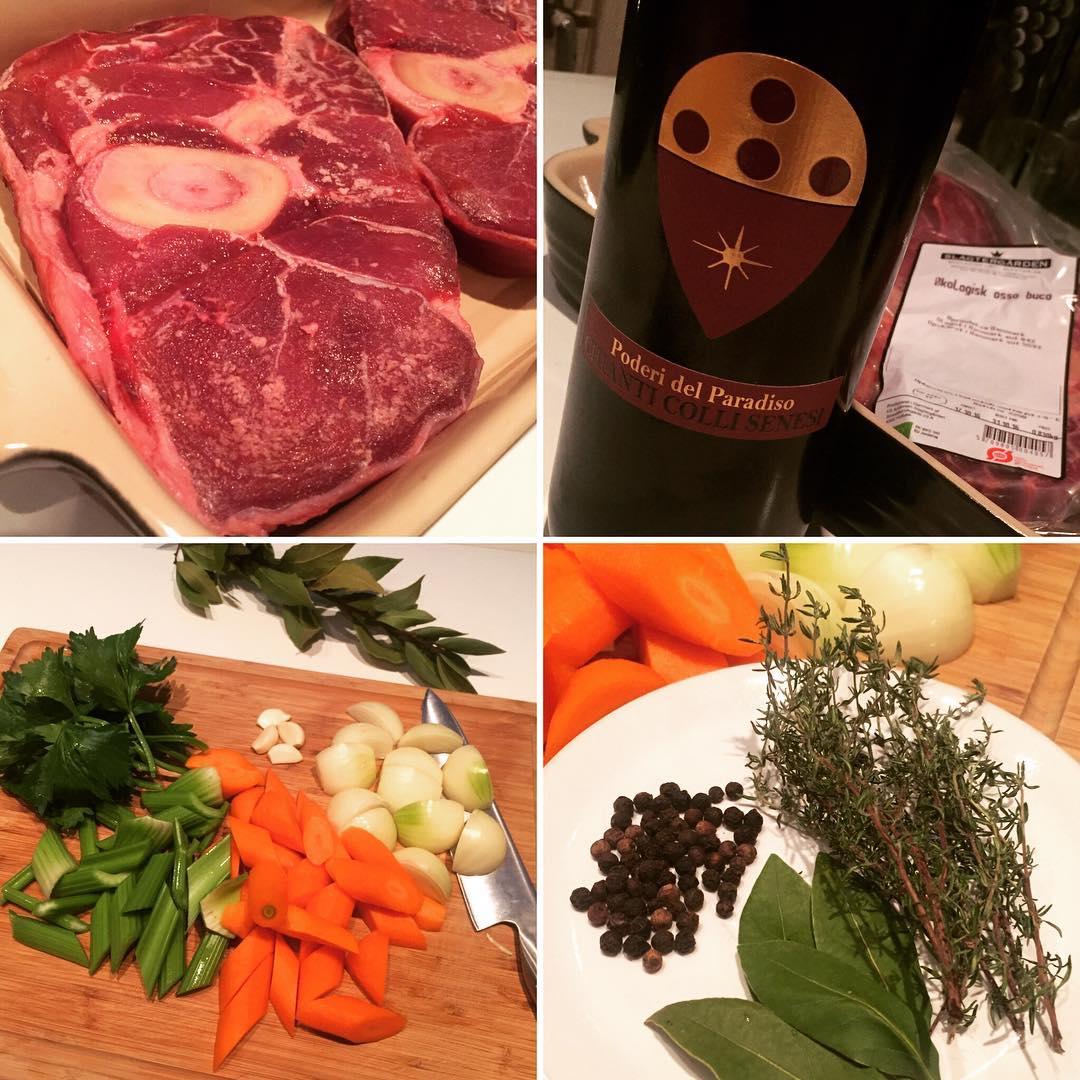
Ingredients for our perfect osso buco recipe – but are they traditional? Uh, well…
Does osso buco contain tomatoes, for example? Today, many home cooks and chefs around the world are inclined to say yes. Ask a passionate and tradition-bound Italian chef, though, and the answer will be a resounding: “NO! Osso buco is made ‘in bianco’, without tomatoes, so tradition demands!”
Indeed, the original version of osso buco appears to have been made without tomatoes – and in some places it still is – but it seems that somewhere along the way, the original version was supplemented by a new pseudo-traditional richer, sweeter and creamier tomato-based version.
Wine, too, is a subject of debate. Not surprisingly, the original non-tomato version uses white wine as a base. Many chefs carry on this tradition into the red tomato-based version for a lighter, more tomato-y sauce while others insist on using red wine for a richer, more robust and powerful sauce.
It goes without saying that neither of the two sides has much regard for the views of the other on such important matters as tomato or wine, but the heated debate runs much deeper than just that. Take vegetables or herbs, for example. Most start out with a classic, Italian soffrito: onions, carrots and celery. Some purists, however, completely scoff at this behavior, insisting that carrots make the dish entirely too sweet. Such scoffing does not deter most cooks, though, who often go so far as to insist on adding garlic or exceedingly fragrant herbs such as rosemary and thyme, an act of pure heresy in the eyes of purists. Just what the traditional vegetable and herb blend for osso buco is, we might never know, but The Guardian has a very interesting article on the matter for those inclined to know more. As for the rest of us who are lucky to have a recipe to follow, we can go on to discuss more important matters such as osso buco side dishes!
Is Risotto alla Millanese really the perfect side dish for osso buco?
Most culinary sources will tell you that risotto alla Milanese is the traditional side for osso buco and while these sources are presumably correct, many foodies will tell you that risotto is simple too dense, rich and heavy of a dish to serve as a side dish for osso buco.
Over the years, numerous substitutions have been attempted, some more successfully than others. A humble loaf of quality bread, for example, works well. Polenta, too, and rice, of the regular old white par-boiled variety. In Northern European in particular, mashed potatoes are often seen as an untraditional but strangely fitting side for osso buco. I’ve even seen pasta as a side which was, ahem, interesting.
Again, obviously, the debate rages: which side dish is better? Team risotto usually has no love for other suggestions while some may go as far as to recognize polenta on account of it being decidedly Italian. Rice, too, maybe, on account of it at least looking and feeling a bit like a dry, light risotto. Pasta and mashed potatoes? Well, they’re popular but will probably never be met with wide approval from purists.

Risotto – the perfect side dish for osso buco? I don’t know, to me it’s more of a main dish in itself!
What is right and what is wrong in this multi-front war to determine just what constitutes a traditional osso buco? Can we even reach some sort of conclusion here? Well, possibly! Given everything we’ve summed up in the paragraphs above and a bit of common sense, we may deduct that osso buco exists in two widely different basic varieties.
A classic tomato-free version, osso buco in bianco, made from veal shank, onions and perhaps other vegetables simmered in white wine, seasoned with various herbs and spices, then served over risotto.
A heavier and richer modern version made with veal shanks, a classic soffrito mix and simmered in a tomato and white (or sometimes red) wine-based sauce best suited for serving over polenta, rice or other starch of your choice.
In this case, risotto may well have been the perfect side dish for the original lighter osso buco, but now that tomatoes and other heavy ingredients have joined the party, maybe not so much anymore.
It’s as simple (and by simple, I mean relatively complicated) as that!
And now we’re going to toss all that knowledge about tradition to the wind and go with Malou’s family version featuring not only tomatoes but also red wine and other tricks! Yes, you heard me! The Johan is going to throw caution and tradition to the wind! Why? Because the recipe we’re about to explore makes a fucking awesome take on osso buco and because sometimes, just sometimes, emotions and memories taste better than tradition.
Breaking the rules: Messing with Osso buco tradition
Firstly and probably most noticeably, this isn’t a osso buco in bianca, it uses tomato, quite a lot of it – for sweetness and for texture. Carrots and garlic, too, for punch and sweetness. Secondly, and perhaps less controversially so, it uses red wine instead of white wine as a sauce base. This, to many, myself included I confess, sounds preposterous. But stick with us, it’s going to work, I promise.
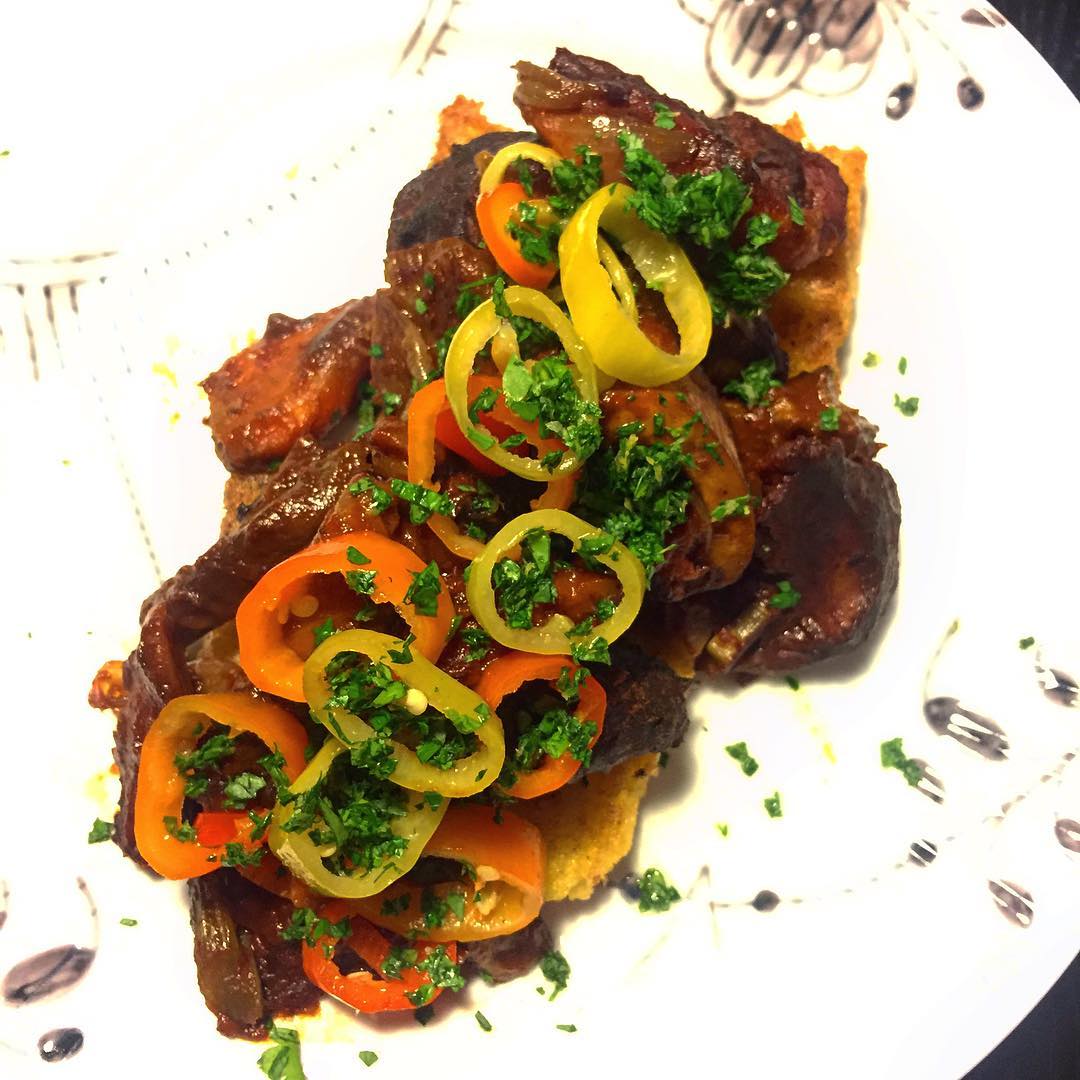
If you’re looking for a traditional osso buco recipe – this post may not be for you. If you’re looking for a fuckin’ rock ‘n’ roll recipe for osso buco – read on!
Last, but certainly not least, it uses beef shanks, not veal. In most traditional recipes, veal is favored for it’s lighter, sweeter taste – but not here, my friends. This recipe calls for full-grown, meaty beef shanks full of flavor and, well, beefiness. Get some big ones, too, if you can. The ones I used were about 400 grams each, full of meat, bone and (very importantly) marrow.
Don’t be shy with your meat or other ingredients, we’re going full on for flavor here and breaking a few traditions along the way. This is Rock ‘n’ Roll cooking and while our choice of ingredients may not be entirely traditional, the result will be perfect and the process may certainly teach us a thing or two (five, actually) about quality ingredients, how to treat them and what we can do to make the most of them.
What makes a perfect Osso buco? Five tips for more flavor
One of the things I really love about this version of this family recipe and procedure is that it encompasses a lot of my favorite cooking tips and flavor-inducing hacks. Here are five ways in which this recipe can teach us to make a perfect osso buco – and while they work perfectly in this context, they can certainly easily be adopted to add more flavor and character to any stewing dish.
Osso Buco tip #1: Browning meat adds flavor
I’ve said it before and I’ll happily repeat myself: When making beef-based stews, your first and most important task is to *brown the meat thoroughly*. In the wonderful world of the kitchen, nothing adds more natural flavor than the complex reactions that happen when a meaty surface meets high heat. Technically, it’s called the Maillard reaction, but we might as well call it culinary magic.
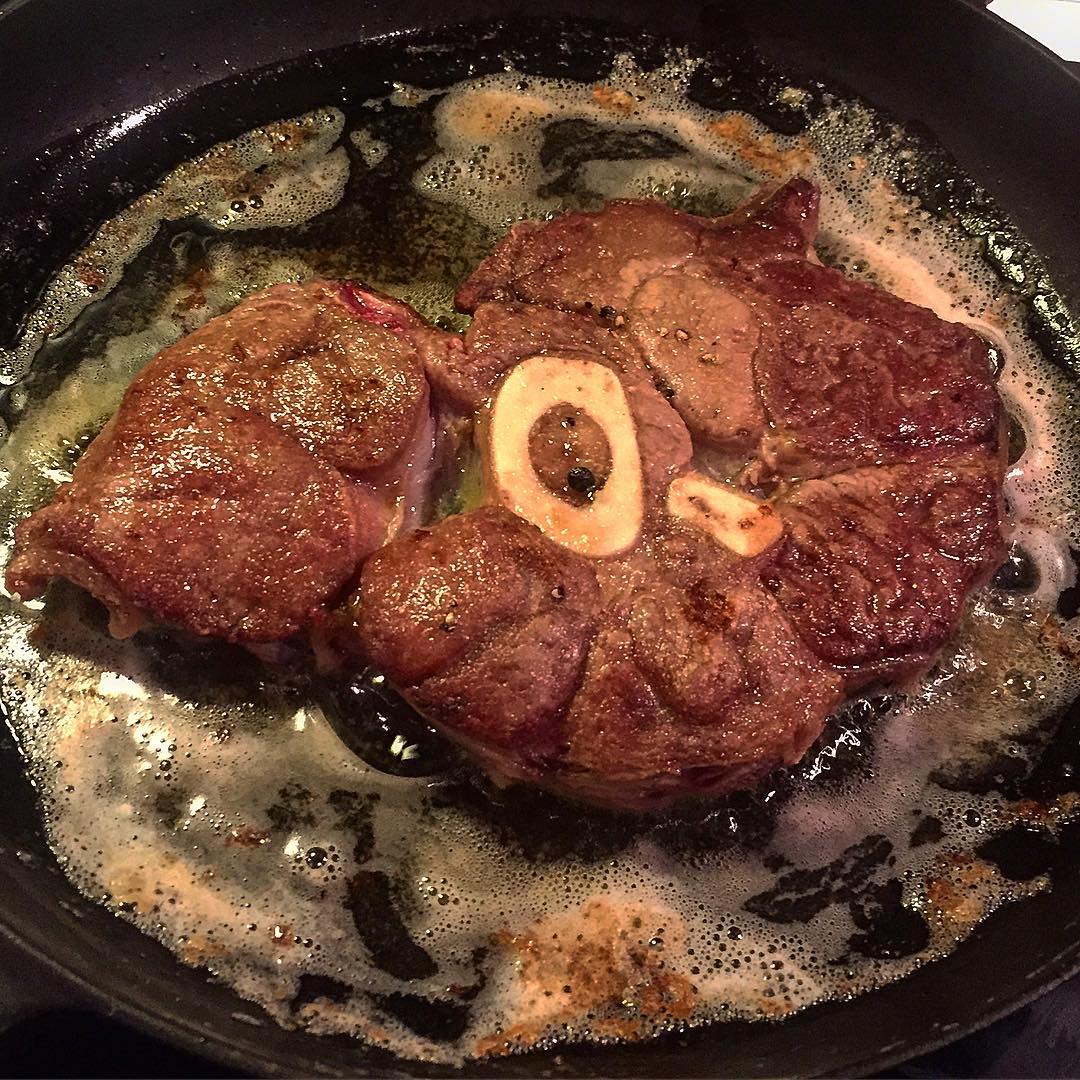
Step one towards perfection: brown your meat – thoroughly!
Whatever you chose to call it, here’s the idea: Use a really hot pan, a fair amount of butter and/or oil and take your time – a couple of minutes per side at least – till the meat is crusty, browned and delicious. And if you’re browning large quantities of meat, have patience and don’t crowd the pan. If you do, the meat will boil before browning, essentially making the process a hell of a lot longer.
Osso Buco tip #2: Brown those veggies, too!
Alright, so you’ve listened and you’ve taken your time getting some good color on those shanks! Great, and you know what, to celebrate I’m going to instruct you to do the same to your vegetables! Yes, indeed! When done browning your meat, give the same attention to your vegetables, add a little extra oil and butter to the pan if needed and get them well and truly caramelized over medium high heat, stirring every now and then as to keep them from burning. Take some time here, work in batches if you must and have patience. Getting some great color on those vegetables will add even more bursts of flavor, color, caramelized notes and sweetness to the final dish and it will absolutely be worth your time. It’s one of those small steps that make a world of difference in richness, taste and appearance of the final dish. It’s also the step most people neglect, and I’m not entirely sure why. I mean, think about it, this entire dish will take about five hours from start to finish, what’s another five to ten minutes if those five to ten minutes mean the difference between a great dish and a stellar dish?
Osso buco tip #3: Quality tomatoes are essential
Alright, quality ingredients are essential, period. But tomatoes are one ingredient where people either knowingly or unknowingly skimp on quality. Either because they assume that fresh tomatoes are always better than canned or because they assume a canned tomato is a canned tomato, regardless of price or brand. Here’s the deal: Unless you live in a tomato growing region and we’re talking the height of the season, quality canned tomatoes are probably your best choice. No shame here. Tomatoes are at their best at the height of the season, and when do you think canned tomatoes are picked, hmm? The small loss in quality imposed by the canning process is absolutely preferable to the disappointment of eating unripe, tasteless tomatoes.
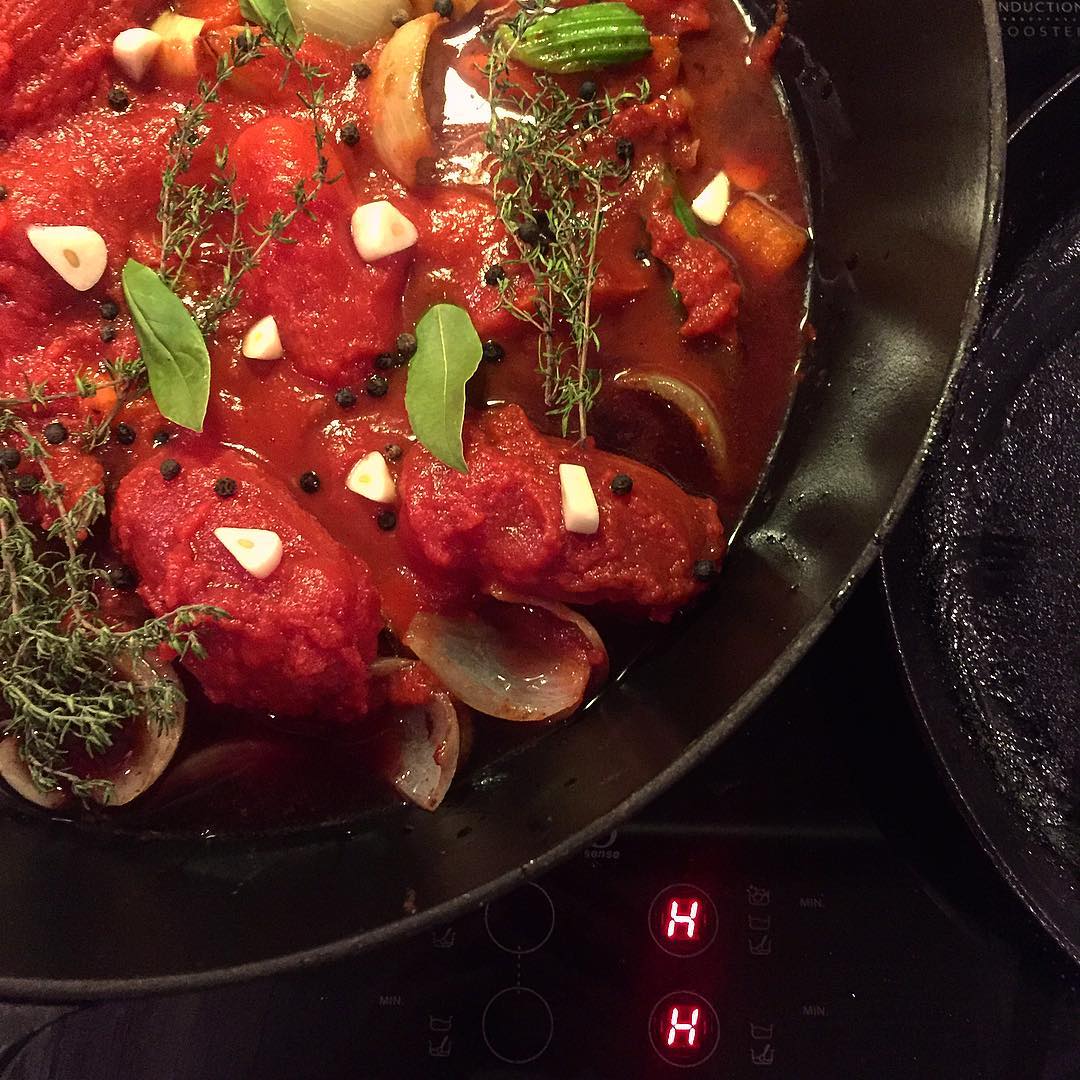
Quality of tomatoes does matter – just look at the color of these beauties!
And be prepared to spend a little here. Canned tomatoes shouldn’t be cheaper than fresh, it’s unnatural considering the picking, processing and shipping costs endured by the producer. Go organic and get a quality brand that employ strict quality control. They will cost you, granted, but the color, flavor and quality will be superior! Want a name? In Europe, try Mutti. In America, try Muir Glen or Red Gold. You can get a cheaper brand, too, of course, but know then that they are probably picked by migrant workers under slave-like conditions with quotas to fill and that you’ll probably spend time cutting off and discarding stems and bitter, green ends.
Osso Buco tip #4: Wine in food – quality and type does matter!
By now, the old chef mantra should have hopefully caught on with most of you: Don’t cook with something you wouldn’t drink! No, seriously, I mean it! These are words to live by! The quality of the wine you use in your food really does matter and bad tasting wine makes for bad tasting food, it’s as simple as that! What’s probably a little less simple is figuring out which wine to cook with. It’s not just a simple question of white wine for fish and chicken and red for meat. It’s considerably more complicated than that.
A number of people, present company included, actually prefer white wines in red meat-based stews like Bolognese or Osso Buco because it adds vibrancy, flavor and fruitiness without the heavy, tannic, oaky punch that some reds bring to the party. That being said, though, on many levels red wines do work very well in heavier meat dishes and winter stews, like, y’know, Osso buco! It adds deeper, darker, red fruit characters and body along with a certain incomparable spice, depth and oomph – plus, as the wine cooks down, the tannins will soften and integrate better into the dish.
However, grape and region does matter, though, when cooking with red wines! I’d really advise steering clear of the heavier, tannic Portugese and Spanish oak monsters along with most Cabernet Sauvignons. They’re simply too heavy, too tannic and too oaky for the purpose. Australian Shiraz is a bad choice, too, unless you want a dish tasting like spiked fruit punch. Aim instead for a lighter, fruitier grape varietal: Pinot Noirs make great cooking wines, as do Merlots and most Rhône-blends. For the purpose of this recipe, I chose a young, light and fruity Italian Chianti with a fair bit of Merlot in the blend and it worked out absolutely beautiful.
Osso Buco tip #5: Acidity greatly elevates flavor in stews
Now, this fifth and final trick may seem a bit weird to some, but stick with me here, it’s absolutely magical! Want my absolute favorite tip for rich stews and creamy soups alike? Hit them with a major shot of vinegar just prior to serving. Not the horrible, distilled white kind, of course, but rather a nice, pungent yet fruity and lightly sweet sherry vinegar or a quality balsamic vinegar if you want it a little sweeter. It may sound incredibly counterintuitive, but the zing of the vinegar will cut the sweetness and richness of the finished dish and make it seem more balanced, considerably more flavorful and, oddly enough, richer. As a matter of fact, this tip can be used to adjust and elevate most types of dishes (save maybe really sweet desserts, obviously) – never forget a splash of acidity when tasting for seasoning.
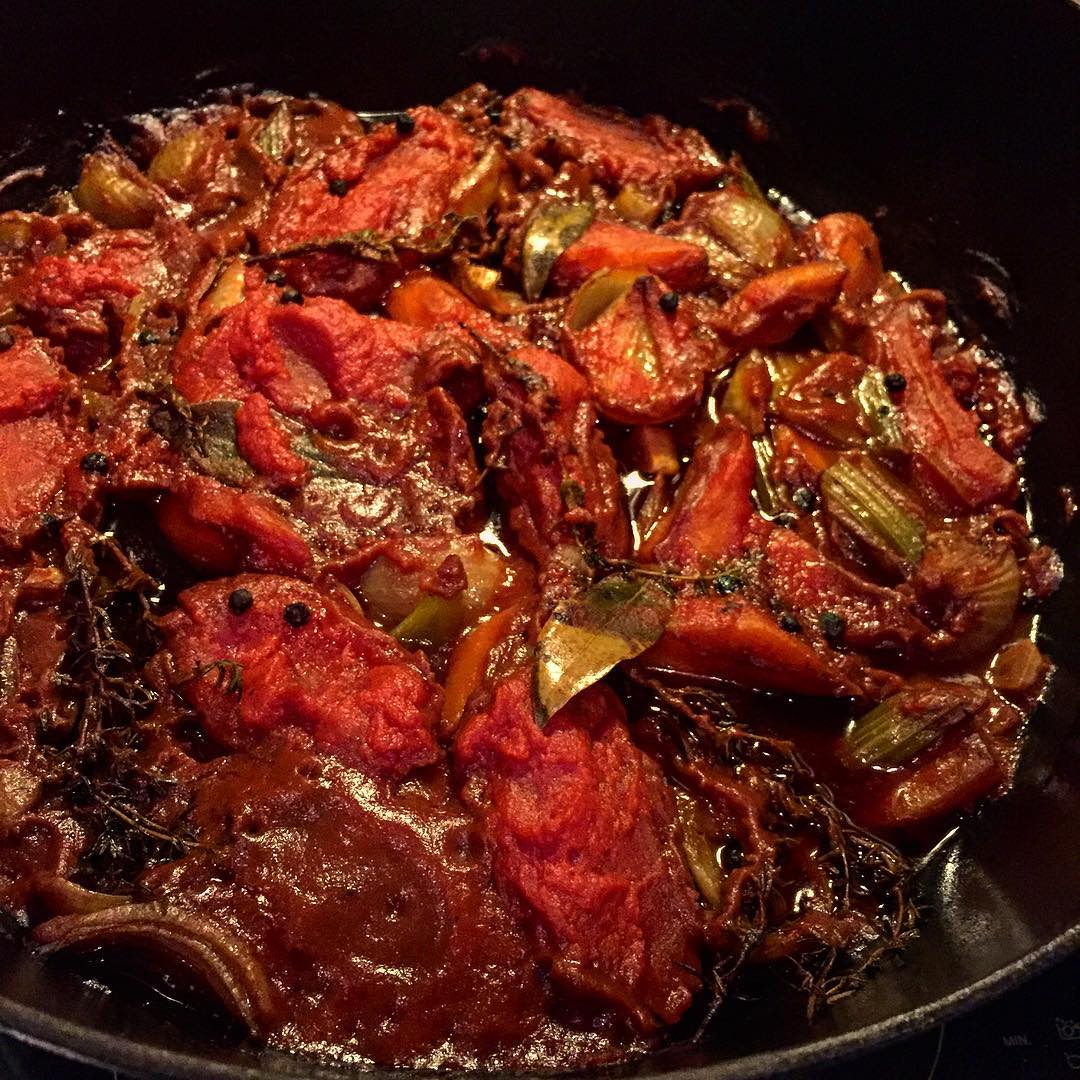
How do we make this hot mess even better? Vinegar! No, really!
Not convinced? Try it out next time and you should be. And don’t panic: if it’s all too much for you, you can simply simmer the dish a little longer to get rid of the raw pungency of the vinegar.
Osso buco: The perfect recipe!
After plenty of research, a bit of planning and some shopping, it was with slightly trembling hands that I set out on cooking the perfect osso buco for Malou during her last visit here back in November. Other than feeling the added pressure of having a champion of the dish watch over my every move in the kitchen, I needn’t have worried, though. While slightly long, this recipe is dead easy to follow.
Before you try your hands with this perfect osso buco recipe, though, know this: This is by no means a fast procedure, it’s quite time-consuming. On the other hand, though, it’s terribly easy to execute and requires very little effort on the part of the coo. Best of all? You can prepare the entire meal in a single large cast iron pot or Dutch oven! Doing so will not only save you some washing up, it will also tremendously increase the flavors of the final dish as no single flavor molecule is wasted in the cooking process but kept right in the pot where it belongs!

Perfect Osso Buco Recipe: A Family Take on Italian Comfort Food
Ingredients
For osso buco:
- 900 grams ox shanks
- 2 medium-sized onions cut into eights
- 3 carrots cut into two centimeter pieces
- 4 stalks of celery cut into two centimeter pieces
- 2 whole, canned tomatoes about 400 grams each
- 350 milliliters Chianti or other Italian red wine
- 150 milliliters beef stock
- 50 grams tomato paste
- 3 garlic cloves
- 3 bay leaves
- 10 sprigs of fresh thyme
- 20 whole black pepper corns
- 50 grams flour for coating the meat
- Salt to taste
- Pepper to taste
- 1 dash sherry vinegar
- 1 tablespoon olive oil for frying
- 1 tablespoon butter for frying
For gremolata:
- Zest of half a lemon
- 3 garlic cloves
- 1 bunch flat leaf parsley
Instructions
Prepare meat:
-
Combine flour, plenty of salt and freshly ground black pepper on a plate and stir well with a fork to combine.
-
Using kitchen shears, poultry shears or a sharp knife carefully cut through the tough tissue surrounding the ox shanks several times leaving about five inches of tissue between cuts. This step is important as to keep the meat from shriveling up during cooking.
-
Preheat oven to 150C while you finish the rest of the process.
Make osso buco:
-
Heat a large Dutch oven over medium high heat for several minutes, add butter and olive oil and let foam up.
-
Grab one piece of ox shank dredge one side in flour, shake off excess, repeat with other side, then carefully transfer to Dutch oven to brown. Repeat with remaining shank(s), making sure not to crowd the pot. Go one at a time if you must.
-
Brown shanks for a couple of minutes on each side, until golden brown and delicious.
-
Once browned on both sides, remove ox shanks from Dutch oven and set aside while you sautée the vegetables.
-
Add carrots to Dutch oven and leave relatively undisturbed to caramelize, about 2-3 minutes.
-
Add onions to the pot and leave once again relatively undisturbed to brown and caramelize, about 2-3 minutes.
-
Add celery and brown for another minute or so.
-
Add tomato paste and fry for about a minute.
-
Add red wine and stir to deglaze the bottom of the Dutch oven.
-
Nestle the shanks back into the pot, add thyme, bay leaves, garlic, whole pepper corns and the whole, canned tomatoes.
-
Cover with a lid and place in oven to cook low and slow for four hours.
-
When ready to serve, return to cook top and adjust seasoning with salt and pepper as needed, add a generous glug of sherry vinegar to cut the richness and sweetness of the dish.
-
Lastly, carefully fish out the bay leaves. They’re not good eats!
Make gremolata:
-
Remove stalks from parsley and chop leaves coarsely.
-
Chop garlic finely using a sharp knife and put in a suitable bowl along with the chopped parsley.
-
Add freshly grated lemon zest and stir to combine.
Serving osso buco:
-
Carefully plate the beef shanks on top of a pile of polenta or other starch of your choice.
-
Add vegetables, sauce and tomatoes as well, doing whatever you can to keep the tomatoes whole, they’re an absolute joy to pop and eat.
-
Be sure to plate the bones as well, some diners know no greater joy than scooping what little marrow remains from the bones and eating it as a buttery delicacy.
-
Sprinkle generously with gremolata and serve piping hot.
Recipe Notes
Not a fan of sherry vinegar? You can use balsamic vinegar for a slightly sweeter, less acidic result.
Stews are better the next day: All good things come to those who wait
When, after about four hours in the oven, we lifted the lid off the steaming hot pan of ossocbuco, we were hit with a complex and primal yet, sweet and floral whiff of tomatoes, herbs and garlic from the thick, rich mass that had gathered at the bottom of my trusty Le Creuset Dutch oven. Anxiously, we dug into the thick, gooey mess.
Carefully transferring the content to a suitable serving vessel proved more difficult than first expected, as the shanks had reached a fall-apart tender consistency that made them more keen to becoming one with the sauce than actually going onto a plate. By this time, our mouths were practically watering but we had one more important step to undertake:
Rather than immediately enjoying the fruit of our labors, we did what any good cook would do. Cooled the contents of the pot down to room temperature and then stuck it in the fridge overnight. While a near torturous experience to hungry diners, this optional but highly recommended step seriously boosts taste by allowing the flavors time to really mingle while allowing the gelatin that has formed from hours of cooking tough connective tissue to blend with the sauce, creating a richer, creamier and much more flavorful sauce on day two.
Regardless of promises and perfect logic, such trade-offs can be hard to comprehend for a hungry Johan, and it was with a scowling face that I went to bed that night, dreaming of things to come.
As day two arrived, I carefully reheated the content of the serving container in a low oven all while whipping up a batch of creamy polenta that – following a heated debate about traditional osso buco side dishes – had been deemed the only feasible side dish for the project.
Relying on a bit of plating help from my beautiful assistant, I then managed to combine my efforts into this:
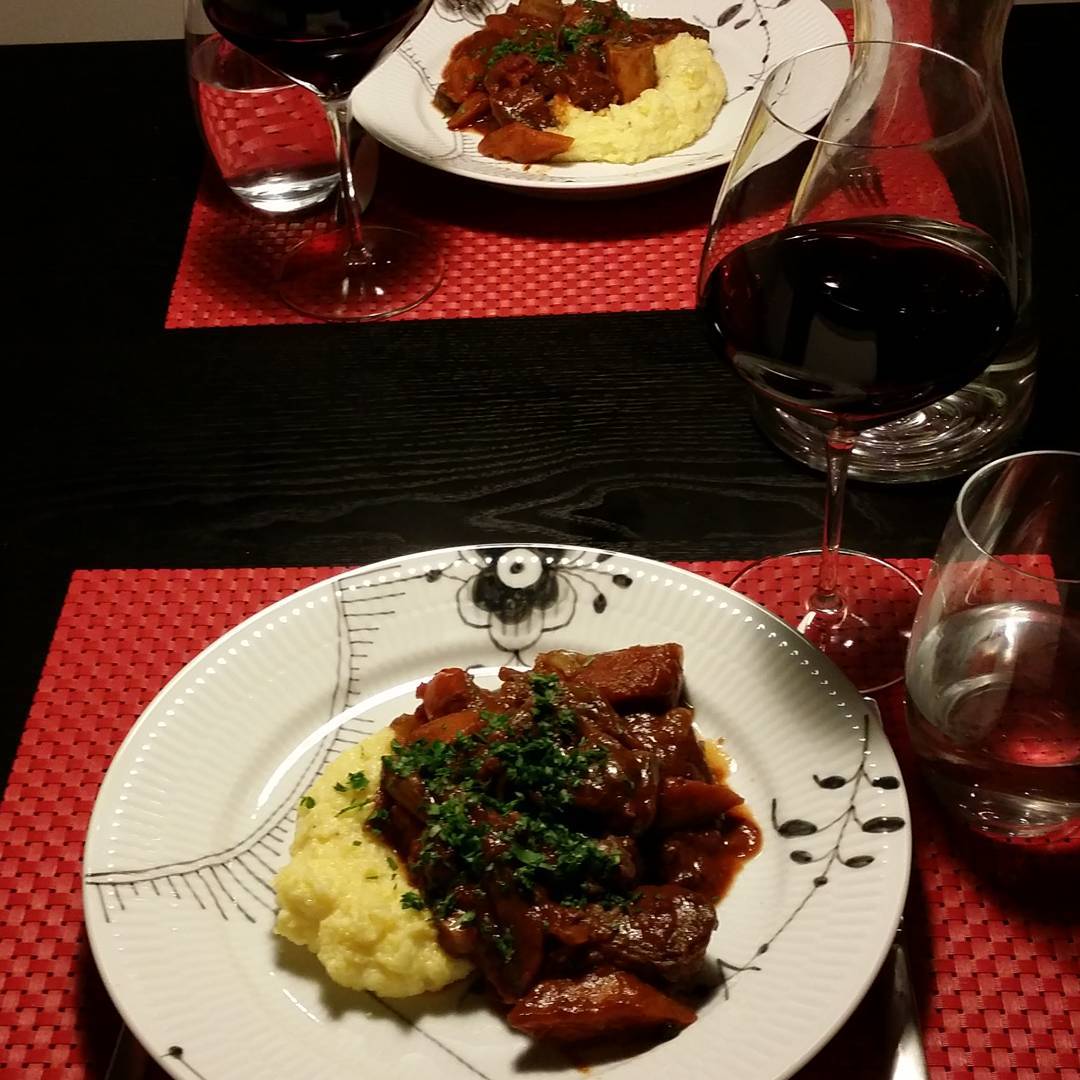
Ah, osso buco perfection! Photo credit: Malou, Klidmoster.dk
The perfect plate of osso buco! Which was served to my guest by a surprisingly humble Johan. It is after all not every day, you get to feed well-renowned food bloggers and super tasters their favorite dish as conceived and perfected by their greatest role model.
Tasting the Perfect osso buco: How was it?
That being said, though, I was more than happy with the results. This treasured family recipe yields an osso buco unlike any I’ve tried before. More beefy, powerful and rich than most, but at the same time sweet, zingy, balanced and beautifully complex. It’s definitely a masculine take on this Italian comfort food classic, but at no point does it seem too overpowering, too rich or too much.
It’s the sort of dish that only comes together through the marriage of quality ingredients, time, dedication and thought. Take the red wine, for example, an ingredient I thought would be entirely too overpowering and dominant, but one that in reality served to counterbalance and smooth out the sweetness of the tomatoes and carrots, creating along with the other ingredients a perfect complexity and balance.
I’m well impressed with the quality and complexity of this seemingly simple recipe and the thoughts and efforts put into it by its creator. I’m only sorry he couldn’t be there to meticulously point out all my obvious errors and slight mistakes.

How was it? An empty plate says more than a thousand words…
And what did the osso buco lover say? Well, not too much to be honest, but sometimes happy sounds, empty plates and misty eyes observed through a glass of Chianti say more than words… Food is feelings, after all! I’d rather like to think I did well with this family recipe and now it’s up there for you to try your hands with it as well.
Hi, I am Italian, I like your blog. However, I have never seen an ossobuco with tomato in my life. Traditionally an ossobuco is never served with tomato because it covers the flavor.
Hi there 🙂 As I mentioned in the post, tomato in ossobuco is highly controversial and probably not traditional. It is, however, the only way we know it up here. I will have to try it without tomato at some point for sure 🙂
Love a great Osso buco and used the recipe for inspiration and it was brilliant with the tomatoes and a whole bottle of Chianti. With the leftover sauce, made a ragu which turned out into a nice bolognese. Skål
So happy you enjoyed the Osso Buco recipe and the resulting Bolognese must have been spectacular 🙂 Skål!!